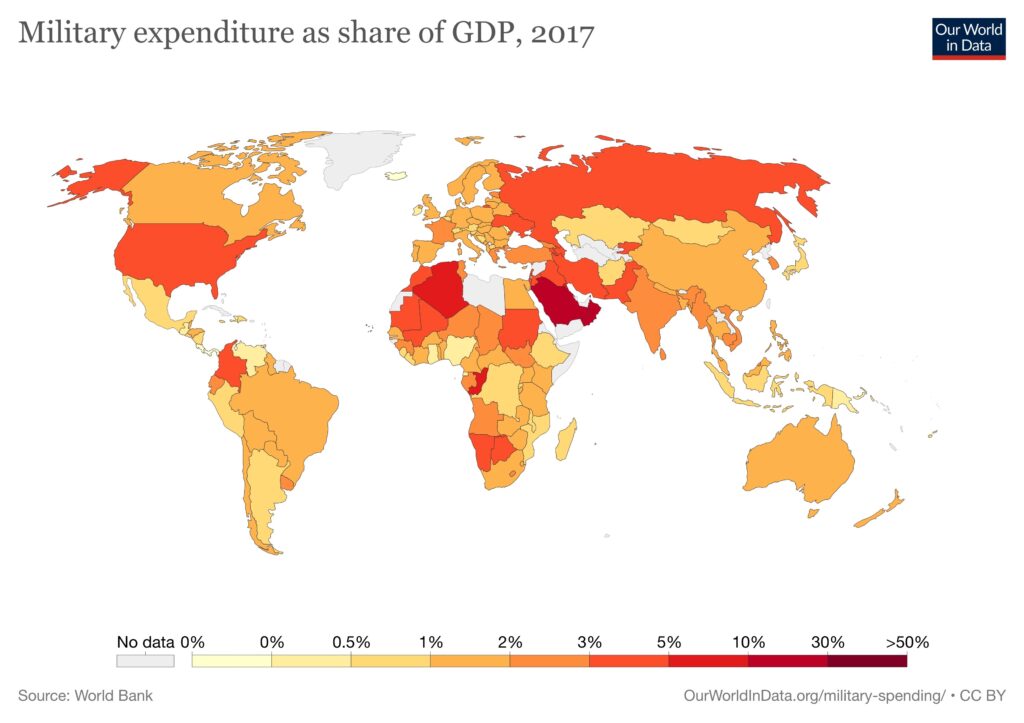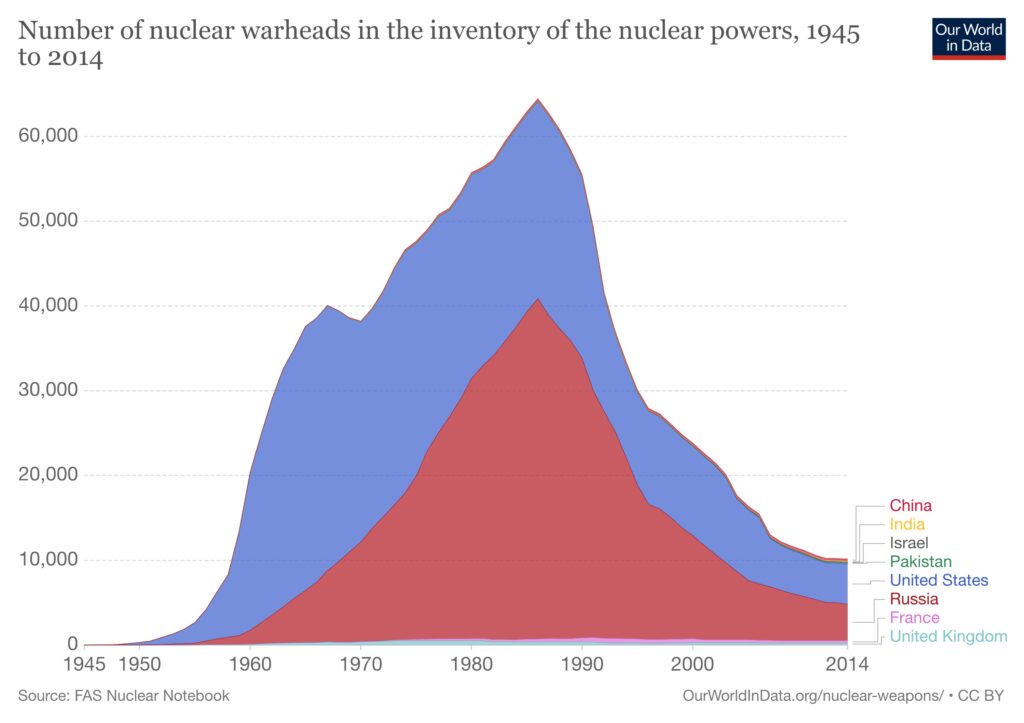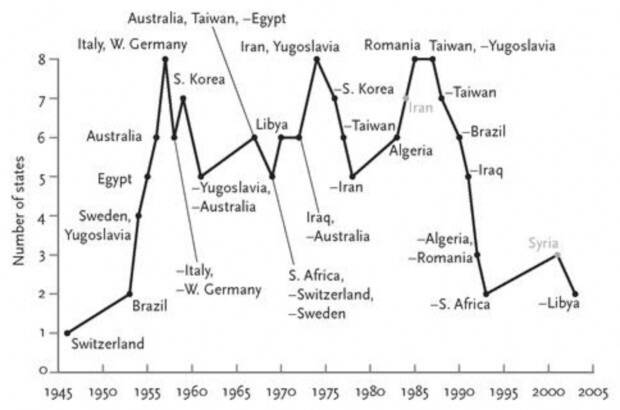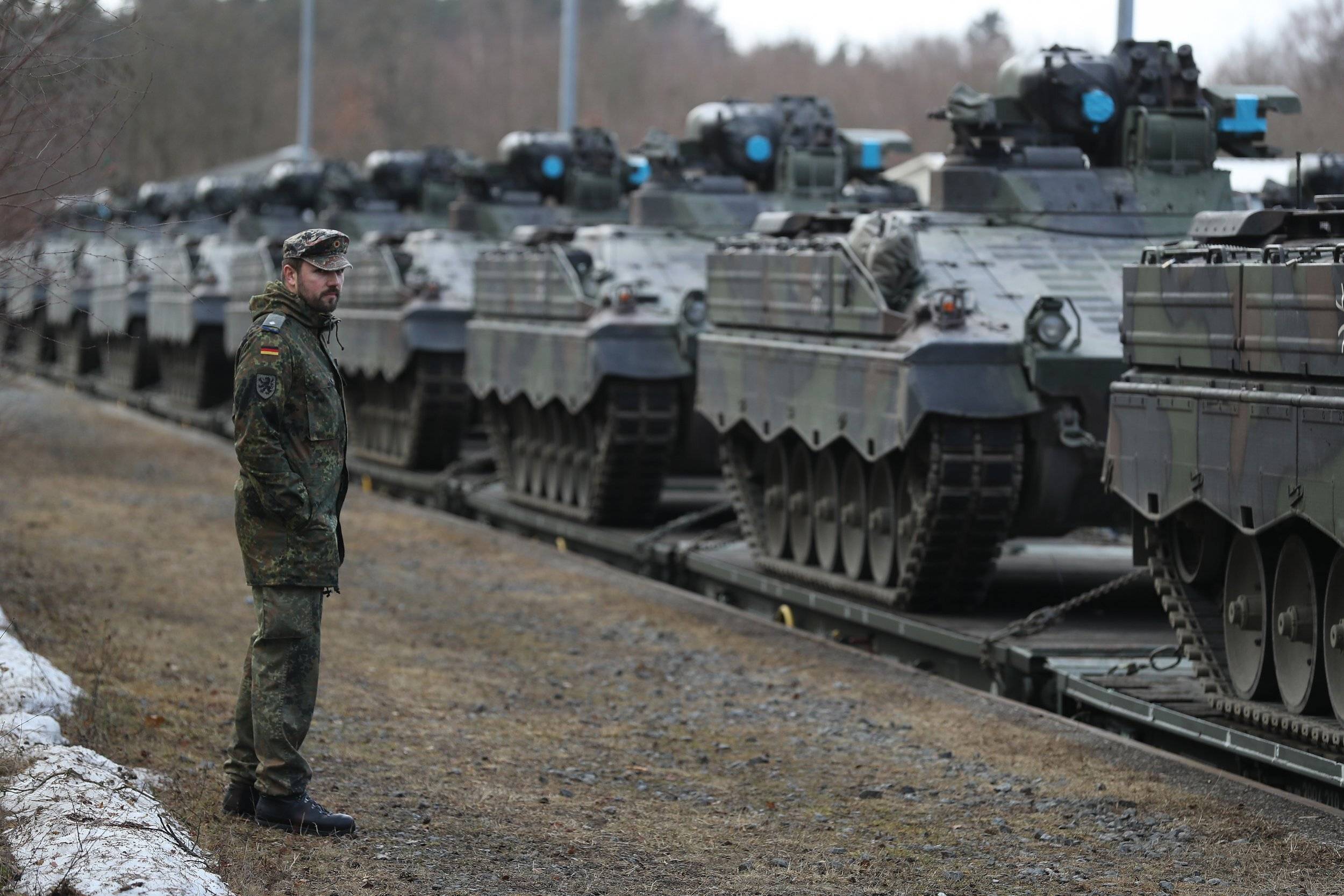Every year, the Arms Control Association (ACA) nominates individuals and organizations for the “Person of the year” of arms control. To qualify for the Arms person of the year, one must have “advanced effective arms control, nonproliferation, and disarmament solutions” as well as “raised awareness of the threats posed by mass casualty weapons”[1]. In 2019, Areg Danagoulian and his colleagues of Massachusetts Institute of Technology received that honor for developing a new method of testing nuclear weapon disarmament. The concerns of the Association for global security and stability are shared by numerous international organizations such as the United Nations and also the international society. For these reasons, a number of mechanisms of peace guarding and conflict control have been created, which, however, haven’t been enough to achieve the Kantian “perpetual peace”.
Let’s try to elaborate on the progress in the world from the perspective of peace and security during the last decades. We will take the end of the Cold War as a key point, trying to understand how the dynamics of the conflict in the world after the Cold War compare to the realities of the Cold War. The selection of the end of the Cold War as a watershed is based on the structural changes it has brought about in global politics and the scientific debate existing among the experts of international relations. Some scientists, such as structural realists, insist that the bipolar system is the most stable system of international relations[2]. Therefore the Cold War, conditioned by its bipolar nature, tended to be stable and its end endangered the stability of the world. Others, such as the liberals, think that the victory of liberal ideology, democratization and the triumph of growing economic interdependence are fertile ground on which international stability can be achieved[3].
The Post-Cold War world
After the end of the Cold War, a number of events took place that did not inspire international stability. The Gulf War, the ethnic cleansing and the war in former Yugoslavia, the Rwandan genocide, the fights in Sudan, the Democratic Republic of the Congo and Somalia, the terrorist attacks and military operations in Iraq and Afghanistan, the ethnic conflicts in Post-Soviet region and other events seemed to confirm the structural realists’ statement that the structural changes of international system can have catastrophic consequences. But are these events in causal relations with the systemic changes? And does this mean that the world is moving chaotically by leaving bipolar stability?
We think that the situation is actually much more encouraging than it may seem. Let’s try to understand what changes occured in the international peace and security system during the last decades on the basis of a few measures. The evaluation is based on the following criteria:
- The number of armed conflicts
- The number of casualties
- Military expenditure,
- Weapons of mass destruction (WMD)
- Structural changes of the international system[4].
The number of armed conflicts

As the diagram of Peace Research Institute Oslo (PRIO) shows, the number of armed conflicts has sharply increased. The internal conflicts and their internationalization condition the majority of the growing armed conflicts. Some examples include the Islamic state and Al-Qaeda’s activities globally, as well as the activities of other Islamist extremist groups in Iraq, Afghanistan, Somalia, Libya and the US’s response to those groups with direct military involvement. A more complicated example is Syria where not only the US but also Russia and Turkey have had (have) direct military involvement, like Iran has through its subordinate organizations.
This situation can be explained by the weakening of the balance in the world conditioned by the Cold War. When the world was divided by the spheres of influence of the USA and the USSR, the supervision of internal violence was easy in the areas controlled by one of the superpowers. For instance, the whole of Eastern Europe was a part of the Warsaw Pact where the USSR had full control, and thus the outbreak of internal violences was less likely․The internal conflicts were more likely on the outskirts which were not divided into zones of influence. Sometimes the outskirts were turned into hotbeds of rivalry between the two superpowers, which later became the focus of multifaceted collisions between the external and internal actors. A vivid example is the Vietnam war which included elements of both internal and interstate and internationalized conflicts.
Now when the situation has changed and there are more than two capable players in some regions, the internal conflicts aren’t as easily controllable as before. The regions that used to be areas of influence for one of the superpowers, currently do not have certain sponsors, and so internal conflicts in these regions are more likely. Some examples include Eastern Europe (the former Warsaw Pact), Africa (during the Cold War, many African countries declared fidelity to the USSR or the US), some countries of Near East. If these regions were somewhat stable during the Cold War, they became focuses of military conflicts after the Cold War [5].
The number of casualties

According to various sources, the number of military casualties has sharply decreased after the Cold War[6]. This can be partly explained by the general regression of interstate conflicts. It’s not a secret that the countries are the biggest military performers after the military alliances and organizations, so the interstate conflicts have more devastating consequences than the internal conflicts. Even in the case of internationalized conflicts, the involvement of international performers is most commonly not against the state but against a certain political or military organization or the political regime in that country (like the US military presence in Afghanistan). Therefore, although the number of armed conflicts has increased, compared to the Cold War period, their non-interstate nature and, consequently, their small scale have led to the drastic decrease in the number of casualties in conflicts.
Military expenditure
World military expenditure drastically decreased in GDP after the Cold War. According to 2017 data, Saudi Arabia and Oman alone spend more than 10% of their GDP. And only three countries-Algeria, the Democratic Republic of the Congo and Kuwait spend in the range of 5-10% of their GDP. The rest of the countries spend less than 5% on armies[7], which has been an unprecedented low rate for the world since the Second World War[8].

This information, however, is two-sided. First of all, this situation is mainly explained by the decrease in the number of interstate military conflicts. On the other hand, it talks about the fact that the considerable part of the states is sceptical about the possibility of huge military collisions in the near future.
But at present, the military expenditure can’t reflect the peace of international relations as well as before. As the PRIO diagram above shows, the majority of contemporary conflicts are civil wars and other types of interstate conflicts initiated by interstate or other global actors. It’s possible to calculate only military expenses of the states, but there is no coordinated data concerning the expenditures of non-state unions. This means that the rate of military expenditure is not absolute and it only applies to states and doesn’t spread to non-state actors.
Weapons of mass destruction (WMD)
The situation regarding WMD has steadily improved since the 90s. More and more states are joining the agreements for preventing WMD production and spread, such as the Biological Weapons Convention, the Chemical Weapons Convention and, most importantly, the Treaty on the Prohibition of Nuclear Weapons. Russia’s and the US’s number of warheads has drastically decreased and the global society has created legal and psychological frameworks for non-use of WMD (nuclear taboo)[9].

However, these restraining mechanisms sometimes undergo testing. For example, the US withdrawal from the Intermediate-Range Nuclear Forces Treaty (INF) was an alarming event. President Trump insisted that Russia violated the Pact by developing certain navigable rockets. Though Russia denied the accusations, the US withdrew from the treaty. Another major blow was Iran’s failure of the nuclear deal and its threats to increase the enrichment of uranium beyond 3.67%.
The future of any nuclear deal with Iran is very hazy, given Trump’s presidency and his reelection prospects, as well as the recent confrontation between the US and Iran.
It’s difficult to predict if there will be more nuclear superpowers in future or not. If we believe the neorealists, the nuclear weapon serves more as a constraining than an attacking factor[10]. The history of using the first nuclear weapon confirms their viewpoint: they have been used only once in 75 years[11].

The possible structural changes of international system or the political rearrangements in the world
After the dissolution of the Soviet Union, the world was mainly considered unipolar, moreover, the US was the only superpower. Many experts think that the structural changes in the world are unavoidable because of the rise of new countries. A vivid example is China which has been a stormy subject for the scientists of international relations since the 2000s. Its rise was one of the primary changes for so-called Pax Americana and the “end of the story” concepts. Although the US authority hasn’t diminished in absolute terms and China is still far behind the US in a wide range of areas, it seems that the US-China relations are already the most important interstate relations in the world especially in economic sense. Regardless of the fact whether China will grow rapidly becoming equal to the US and creating a bipolar regime or other actors (like India) will catch up them and we’ll live in a multipolar world, the status quo of the world is already changing, and it’s conditioned not by just China’s rise. Changes are noticed both in the course of US foreign policy and in the policies of European Union and Russia. On the one hand there is the withdrawal of the UK from the EU, on the other hand there is certain deterioration in EU–US relations, and then there is Russia that has started an integration policy in the Post –Soviet period (Eurasian Economic Union, Collective Security Treaty Organization).
The Near East is not immune to these changes too (US-Iran, Russia–Turkey-West relations).
Summing up the above-mentioned factors, most of the indicators of the article are promising for the future peace and security. State military expenditure has decreased more and more in terms of the percentage of GDP, the military collisions are less deadly and the WMD situation, despite staying fragile, has comparatively improved. The main concerning indicator is the growing number of the internal and internationalized conflicts which, in its turn, is conditioned by certain geopolitical rearrangements.
And these geopolitical rearrangements or the possible structural changes in the international system are always fraught with possible conflicts, including military ones. However, it’s encouraging that those changes have already been going on for about two decades, and we haven’t had massive military conflicts between superpowers. On the other hand the interdependence, formed during many years, can become a stimulus for a peaceful settlement of disputes.
References
[1] 2019 Arms Control Person(s) of the Year Nominees Announced. https://www.armscontrol.org/pressroom/2019-12/2019-arms-control-persons-year-nominees-announced
[2] Kenneth Waltz, Theory of International Politics. McGraw-Hill, 1979.
[3] Robert O. Keohane, After Hegemony: Cooperation and Discord in the World Political Economy. Princeton University Press, 1984.
[4] Trends in Armed Conflict, 1946–2017. PRIO. https://reliefweb.int/sites/reliefweb.int/files/resources/Dupuy%2C%20Rustad%20Trends%20in%20Armed%20Conflict%2C%201946%E2%80%932017%2C%20Conflict%20Trends%205-2018.pdf
[5] Trends in Armed Conflict, 1946–2017. PRIO. https://reliefweb.int/sites/reliefweb.int/files/resources/Dupuy%2C%20Rustad%20Trends%20in%20Armed%20Conflict%2C%201946%E2%80%932017%2C%20Conflict%20Trends%205-2018.pdf
[6] Max Roser (2020)-“War and Peace”. Published online at OurWorldInData.org. Retrieved from: ‘https://ourworldindata.org/war-and-peace’ [Online Resource]
[7] Max Roser and Mohamed Nagdy (2020)-“Military Spending”. Published online at OurWorldInData.org. Retrieved from: ‘https://ourworldindata.org/military-spending’ [Online Resource]
[8] Ibid
[9] Max Roser and Mohamed Nagdy (2020)-“Nuclear Weapons”. Published online at OurWorldInData.org. Retrieved from: ‘https://ourworldindata.org/nuclear-weapons’ [Online Resource]
[10] Kenneth Waltz (2012) Why Iran should get the bomb. Nuclear Balancing would mean stability. Foreign Affairs;91 (4): 2–5.
[11] Pinker, Steven. The Better Angels of Our Nature: Why Violence Has Declined. Figure 5-22. Penguin, 2011.
Bibliography
- 2019 Arms Control Person(s) of the Year Nominees Announced. https://www.armscontrol.org/pressroom/2019-12/2019-arms-control-persons-year-nominees-announced
- Kenneth Waltz (2012) Why Iran should get the bomb. Nuclear Balancing would mean stability. Foreign Affairs;91 (4): 2–5.
- Kenneth Waltz, Theory of International Politics. McGraw-Hill, 1979.
- Max Roser (2020)-“War and Peace”. Published online at OurWorldInData.org. Retrieved from: https://ourworldindata.org/war-and-peace [Online Resource]
- Max Roser and Mohamed Nagdy (2020)-“Military Spending”. Published online at OurWorldInData.org. Retrieved from: https://ourworldindata.org/military-spending [Online Resource]
- Max Roser and Mohamed Nagdy (2020)-“Nuclear Weapons”. Published online at OurWorldInData.org. Retrieved from: https://ourworldindata.org/nuclear-weapons [Online Resource]
- Robert O. Keohane, After Hegemony: Cooperation and Discord in the World Political Economy. Princeton University Press, 1984.
- Trends in Armed Conflict, 1946–2017. PRIO https://reliefweb.int/sites/reliefweb.int/files/resources/Dupuy%2C%20Rustad-%20Trends%20in%20Armed%20Conflict%2C%201946%E2%80%932017%2C%20Conflict%20Trends%205-2018.pdf
Author: Gevorg Gasparyan © All rights reserved
Translator: Jemma Khachatryan.









